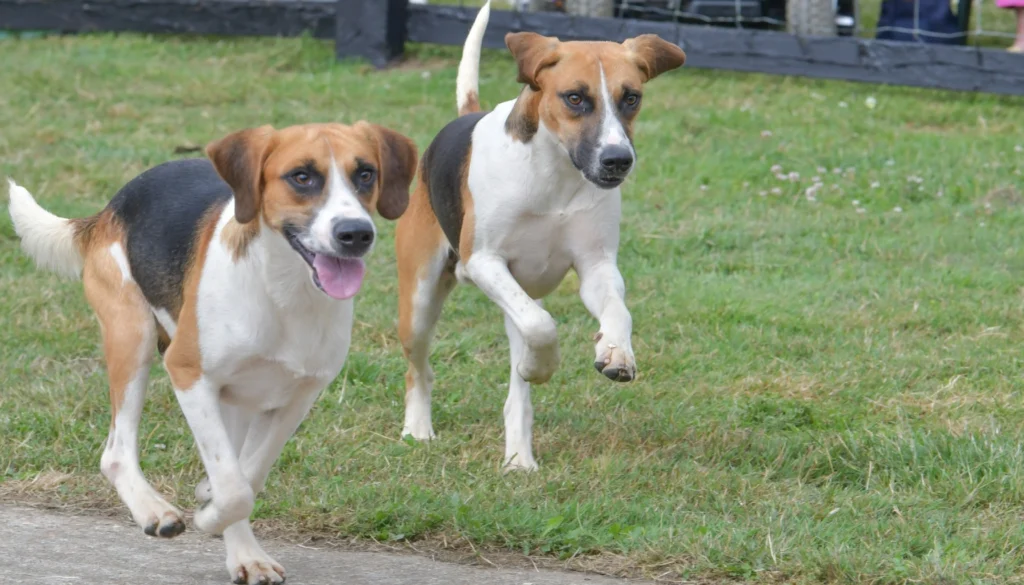Table of Contents
🐾 Harrier Dog Breed: Characteristics, Temperament, Care Tips

The Harrier is a medium sized hound dog breed known for its remarkable endurance, keen sense of smell, and friendly nature. Bred primarily for hunting, the Harrier has a strong work ethic and an energetic personality, making it an excellent companion for active owners. Despite its hunting background, the Harrier is also a loving and loyal family pet, known for getting along well with children and other animals. In this article, we’ll dive into the history, characteristics, temperament, and care needs of the Harrier to help you determine if this breed is the right fit for you.
📜 Short History
The Harrier has a rich history that dates back to medieval England, where it was originally bred for hunting hares and foxes. The breed’s name itself is derived from the word “hare,” reflecting its primary purpose. The exact origins of the Harrier are somewhat murky, but it is believed to be a descendant of the Bloodhound, Foxhound, and possibly even the now-extinct Talbot Hound.
Harriers were first developed by crossing smaller hounds with larger ones, resulting in a dog with the stamina and speed necessary for chasing game over long distances. The breed’s popularity grew among hunters due to its ability to work tirelessly in the field, often in packs. By the 13th century, Harriers were well established as a favorite among English hunters, prized for their keen noses, tenacity, and endurance.
In the 19th century, Harriers were brought to America, where they continued to be used for hunting. While the breed is not as common today as some other hounds, it remains a beloved companion for those who appreciate its hunting prowess and friendly disposition.
📌 Quick Facts & Essential Details

| Category | Details |
|---|---|
| 🏷 Breed Name | Harrier |
| 📛 Other Names | None (simply known as Harrier) |
| 📍 Origin | United Kingdom |
| 🏆 Recognized By | AKC, FCI, UKC |
| 🔢 Size Variants | Medium-sized hound |
| ⚖ Weight Range | 45 – 65 lbs (20 – 29 kg) |
| 📏 Height Range | 19 – 21 inches (48 – 53 cm) |
| ⏳ Lifespan | 12 – 15 years |
🐕🦺 Coat & Appearance
| Category | Details |
|---|---|
| 🧥 Coat Type | Short, dense, and hard coat |
| 🎨 Coat Colors | Tri-color (black, tan, white), lemon & white, red & white, or any typical hound coloring |
⚡ Energy & Personality

| Category | Details |
|---|---|
| 🔋 Energy Level | Very high |
| 🏅 Breed Group | Hound Group |
| 🧠 Temperament | Friendly, pack-oriented, energetic, outgoing |
| 🏠 Apartment-Friendly? | Not ideal—prefers space and frequent activity |
| 🎓 Trainability | High—smart, eager to please, but easily distracted by scents |
🩺 Health & Care Needs
| Category | Details |
|---|---|
| ⚕ Common Health Issues | Hip dysplasia, ear infections, hypothyroidism |
| ✂ Grooming Needs | Low—weekly brushing and regular ear cleaning |
| 🍂 Shedding Level | Moderate |
| 🏃 Exercise Needs | Very high—needs vigorous daily walks, runs, or scent games |
❤️ Suitability & Compatibility

| Category | Details |
|---|---|
| 🏡 Best For | Active families, rural homes, hunters |
| 🚫 Not Ideal For | Sedentary owners, apartment living |
| 🔊 Barking Level | Moderate—vocal, especially when excited or tracking |
| 👶 Good With Kids? | Yes—gentle and tolerant when socialized early |
| 🐾 Good With Pets? | Yes—especially with dogs, but watch around small animals |
| 👩🏫 First-Time Owner Friendly? | Yes—with time for training and exercise |
| ☀️ Weather Tolerance | Good in moderate climates—protect from extreme cold or heat |
🎉 Fun & Extra Info
| Category | Details |
|---|---|
| 🌟 Famous Dogs of This Breed | Historically used in royal hunts and hunting packs in the UK |
| 🧠 Intelligence Level | High—excellent in scent tracking and hunting |
| ⚠ Common Behavioral Issues | Roaming, barking, digging if under-stimulated |
| 🥘 Best Diet | Protein-rich diet designed for active breeds |
| ❌ Foods to Avoid | Chocolate, grapes, onions, greasy table scraps |
| 🤩 Fun Fact | Despite their name, Harriers are not related to the bird of prey—their name comes from the Norman word “Harier,” meaning hound! |
| 💰 Price of Puppy | $1,000 – $2,500 (rare outside of working or hunting circles) |
✅ Final Thoughts
The Harrier is a cheerful, active, and loyal pack hound, perfect for outdoorsy families and active individuals. With its keen nose, stamina, and playful spirit, the Harrier makes a wonderful hunting companion or family dog—just be ready to keep up! If you want a friendly, athletic, and adventurous dog, the Harrier is a fantastic choice. 🐾🎯🐕
🐶 Dog Breeds Similar to the Harrier



If you’re considering the Harrier, you might also be interested in these similar breeds:
- Beagle: The Beagle is a smaller hound breed known for its friendly nature and keen sense of smell. Like the Harrier, Beagles are excellent hunters and family pets, but they are more compact and slightly less energetic.
- Foxhound: The English Foxhound is a larger hound breed with a similar build and temperament to the Harrier. Foxhounds are also pack hunters with a strong prey drive and a need for plenty of exercise.
- Basset Hound: The Basset Hound is a short legged hound with a strong sense of smell and a laid back personality. While not as energetic as the Harrier, Basset Hounds share the same love for tracking scents and are known for their friendly demeanor.
Conclusion
The Harrier is a lively, intelligent, and versatile breed that excels in both hunting and as a family companion. With its friendly nature, strong work ethic, and relatively low-maintenance coat, the Harrier is a great choice for active families and individuals who can meet its exercise and mental stimulation needs. Whether you’re looking for a hunting partner or a loving pet, the Harrier offers a blend of loyalty, endurance, and fun that few other breeds can match.
If you’re interested in learning more about the Harrier or considering adding one to your family, be sure to research thoroughly and consider contacting reputable breeders or rescue organizations.
FAQs
Is the Harrier a dangerous dog?
No, the Harrier is not considered a dangerous dog. They are generally friendly, affectionate, and loyal to their families. However, like all dogs, they need proper training and socialization to ensure they are well behaved and comfortable around people and other animals.
Is the Harrier the best guard dog to protect my family?
While the Harrier is alert and will likely bark at unfamiliar situations, it is not typically considered a guard dog. Harriers are more likely to greet strangers with curiosity rather than aggression. They are better suited for families looking for a friendly and energetic companion rather than a guard dog.


